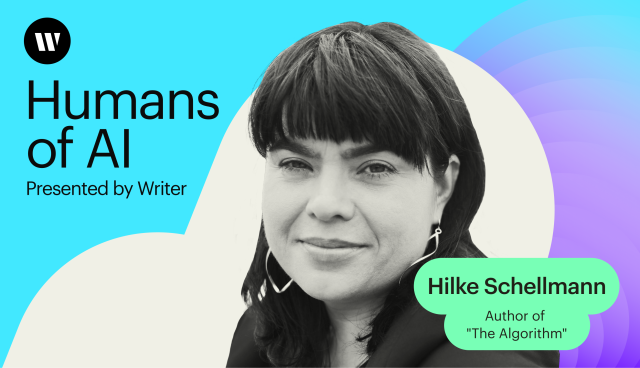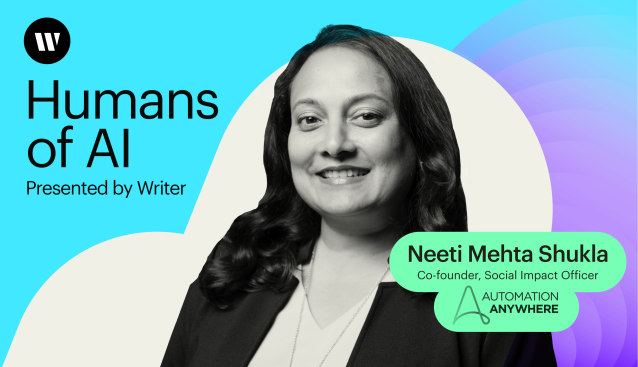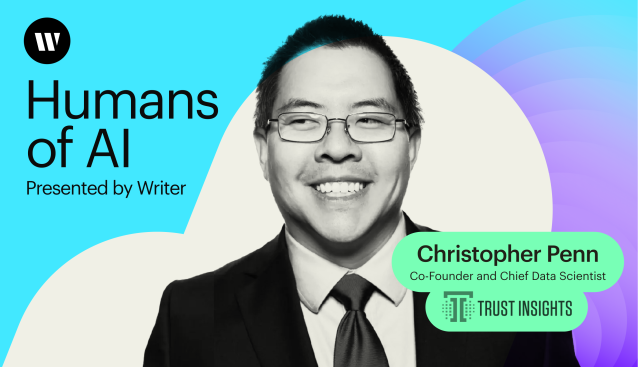Humans of AI
– 8 min read
Healing with AI: Joanna Taylor’s vision for healthcare equity

It is rare to find optimism in women’s healthcare, but AI technology is indeed changing that narrative. We’ve witnessed how AI is bridging gender disparities and enhancing tech accessibility. Is the healthcare sector experiencing the same transformation?
In this installment of Humans of AI, we have a conversation with Joanna Taylor, the Senior Vice President for R&D at BASE life science. She’s spent 20 years working at the intersection of business and technology in the field of life sciences and healthcare. Jo sheds light on the challenges faced by women in healthcare, the impact of historical inequity, and how AI can be a powerful tool in closing these gaps.
But this conversation isn’t just about women’s health — it’s about the future of healthcare. By addressing the gender and data gap, we can create a more holistically inclusive and equitable healthcare system that benefits everyone.
- Jo’s journey highlights the intersection of AI, life sciences, and healthcare, driven by a purpose to make a meaningful impact and address complex societal challenges.
- The gender and data gap in healthcare has resulted in suboptimal treatments and outcomes for women, emphasizing the need for AI to bridge this gap.
- AI has the potential to streamline healthcare processes, customize care plans, and enable personalized treatments.
- Jo stresses that ethical implementation and data privacy are crucial to ensure fairness, transparency, and trust in AI’s use in healthcare.
The intersection of AI, life sciences, and healthcare
Jo’s journey into the world of life sciences and healthcare wasn’t a planned one. With a background in math and business, she stumbled into the field while working on a project with a life sciences customer. Little did she know this would be the start of a 20-year career at the forefront of business and technology in the healthcare industry.
She’s stayed in the field for so long because it gives her a sense of purpose. Every morning, Jo gets up with the aim of making a difference in the issues our society is dealing with. In healthcare specifically, those problems can be more difficult to solve.
“With some of these complex problems, there’s not one straight solution to them. And that’s also part of the mental stimulation that comes from working in the industry,” she explains. “It’s also why I think I’ve stayed in it for so long, because there are some really exciting and interesting problems and opportunities out there that still need to be addressed.”
One of these opportunities lies in the conversation around physical health and the world economy. In the last 12–18 months, research has come out linking healthy populations to healthy economies. Jo uses her corporate and commercial background to address health from a business and tech perspective — which is where AI comes in.
“We see AI already being used in terms of aiding diagnosis of conditions. We see it in terms of the MRI images, the mammograms, and x-rays that are taken,” Jo says. “AI can be used to help identify breast cancer or lung cancer, or look at the pap spheres and then detect cervical cancers.”
The gender gap in healthcare
Jo learned about the lack of women participants in clinical trials while conducting research for her PHD. Many treatments available on the market today weren’t tested on women when they were initially developed and approved. It wasn’t until 1993 that the inclusion of women and marginalized communities in clinical trials became law.
The consequences of this gender gap are significant. Women may receive incorrect dosages of prescribed treatments. They may also experience delays in diagnosis — or even misdiagnosis — as much of the medical knowledge and research is based on male models.
All of this can result in a lack of tailored treatments and care. Jo saw that underinvestment in women’s health and the lack of awareness around gender-specific conditions were contributing factors to this gender gap.
“One of the things that we know across all industries actually is that there’s a lot of underinvestment in women-led organizations, but also in terms of addressing some of the health issues that women face.”
Conditions such as multiple sclerosis, Alzheimer’s, and cardiovascular disease are more prevalent in women, yet the symptoms and treatment approaches are often misunderstood or overlooked.
“A lot of the research that’s been done doesn’t distinguish between how much of the cohort of patients that were involved were men or women,” she explains. “They got grouped together and that obviously then influences the outcome of the analysis.”
Not only is there a lack of awareness around these things, there’s a lack of education and research and data. Jo believes there’s still a lot more science needed to address the knowledge gap and the data gap that currently exists.
“I think there’s a lot of misconceptions around it and there’s a lack of scientific evidence around it,” Jo says. “Not just in terms of reproductive and sexual health or maternal health or anything like that, but just in the broader context of ‘How do different diseases affect women and men differently?’”
Addressing gender inequality with AI
Malcom X is famous for saying, “If not now then when, if not me then who?” Jo speaks to her professional progression, and how reaching a position of seniority made her realize how pertinent this quote is.
“If others aren’t going to take this seriously and do something about it, then who’s going to do it? We are. We’re going to go and raise awareness about it and invest in it and hopefully make a positive impact in addressing some of the gaps that we see,” Jo states. “But it’s a long journey. I don’t think it’s something that’s necessarily going to be fixed overnight.”
AI offers a promising avenue to bridge this gender gap and provide better healthcare outcomes. Jo thinks AI-driven synthetic data sets are a perfect example of how we can help fill in the gaps of missing data from the last 30 years.
Personalized, efficient healthcare with AI
Research and development (R&D) can be extremely manual and labor-intensive. Efficiency is key when you’re trying to get new treatments to market and gain approval from health authorities.
A BCG report estimates that AI-driven R&D efforts from discovery up to preclinical could deliver time and cost savings of at least 25-50%. When you put that in the context of how long it can take a drug to go through clinical development — which can take years — the efficiency gains are exciting. AI is showing massive potential to get new treatments to market quicker.
Jo also sees opportunities in the patient experience. Every patient is unique — from their genetic makeup to their family history around certain conditions — and there’s potential for AI to customize care plans around an individual’s unique needs.
“A really good example of that is cell and gene therapies where it’s not a one-treatment-fits-all kind of thing,” she explains. “It’s a specific treatment that is tailored specifically to that individual because it’s based on either a sample of their cells or a sample of their blood, et cetera.”
Challenges and considerations in implementing AI
While the integration of AI into healthcare systems offers exciting opportunities, Jo notes a few areas that require a degree of caution. Robust data governance practices and secure infrastructure are essential to maintain patient trust and safeguard sensitive information.
“We’re dealing with people’s health, and of course there’s data privacy elements around this — particularly using genetic data as part of the models,” Jo explains. “There’s also an element of how comfortable are patients — how much do they trust the algorithms? Do they trust what the outcome of those algorithms are, and are they being used ethically?”
Maintaining momentum
Jo sees firsthand that the outlook on AI is starting to shift from hype-generating buzzwords to a focus on education, investment, and advocacy. She envisions a pragmatic approach where AI becomes a normal part of business.
“People used to talk a lot about robotics and things like that. Those are things that are part of what exists already, but that’s how emerging tech then gets embedded in the way that we operate,” Jo says. “People don’t even think about it anymore, or necessarily see it as a different or unusual way of working.”
Jo hopes that we can build on AI’s momentum and continue implementing AI in healthcare systems to close the gender and data gap.
“We all have a role to play,” Jo stresses. “Having benefited from my professional growth journey, it’s now time to actually take that and do something that’s meaningful.”
Women’s health is a complicated issue, caught in a tug of war between science and centuries of sexism. It’s not often you feel hopeful about women’s health or the future of healthcare as a whole. But as Jo explains, AI is offering us a chance to hit reset and fill the decades-long gap that’s permeated the industry. Using AI to address the health of female bodies will also set a template for closing the healthcare gap for other underserved populations. We need to keep the ball rolling, because if not now, then when?
Want to hear more stories from the humans working at the crossroads of business and generative AI? Subscribe to Humans of AI wherever you listen to podcasts.




